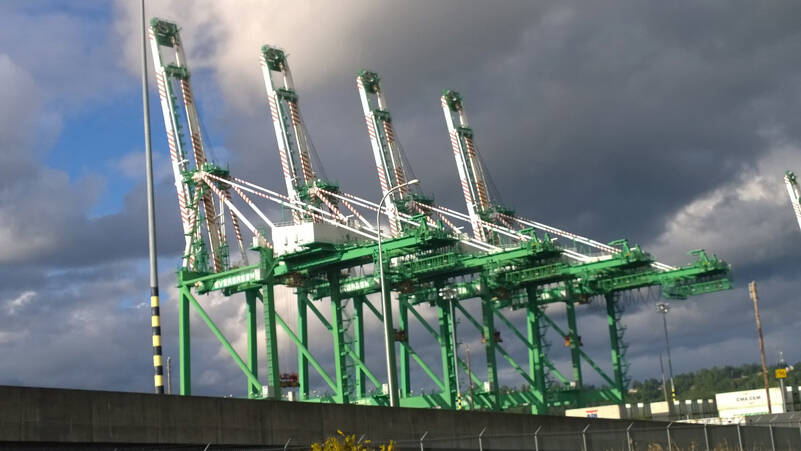By Morf Morford
Tacoma Daily Index
With the landscape of “smart” cars, phones and even cities, it was inevitable that a system with as many moving (and essential) parts as a global port would, in some capacity, move towards being “smart”.
Like individuals, cities don’t become “smart” on their own.
And also, like individuals, cities often don’t become “smart” unless they have to.
The much-heralded supply-chain bottleneck has put ports, for better or worse, at the center of the controversy.
Here in Tacoma, many thousands of jobs depend on the port – the number of jobs far from here – from Iowa to Shenzen – are in the hundreds of thousands.
Those jobs, and literally the food on our tables, all depend on the smooth running of our port – and many others like it.
In pursuit of that goal, and with the global supply chain in near-total disarray and container ships moored in seldom-used Puget Sound anchorages, Washington signed a timely memorandum of understanding with the government of Finland that includes plans to establish a so-called smart port in Tacoma as early as 2022.
Finland’s largest port, HaminaKotka, is currently unloading cargo ships in half a day, far faster than clogged harbors elsewhere in the world.
The intention is to get ports to act more like airports with less waiting time for each component to get where it is needed.
This is, of course, far less expensive and more predictable – but it is also vastly better for the environment.
You can see more details on this development here: https://www.geekwire.com/2021/washington-state-finland-sign-mou-establish-smart-port-tacoma/.
As we have seen with shipping containers breaking loose from ships, as winter weather moves into the Puget Sound, it is even more crucial that the U.S. Coast Guard (USCG) and Pacific Merchant Shipping Association (PMSA) are coordinating efforts to keep vessels safe and moving efficiently in our waterways.
Ships waiting to be unloaded are an expense and a hazard.
On the environmental front, The Port of Seattle Commission voted to accelerate its emission reduction efforts by ten years to be net zero or better for Port-owned emissions by 2040.
The Port also committed to accelerating and expanding its goal for emissions from industries operating at its facilities to be carbon neutral or better by 2050.
Among other things, The Port is also making significant investments in green infrastructure, such as shore power, to enable tenants to meet their climate goals as well.
The Port also announced participation in new exploratory studies of renewable hydrogen as a future vehicle and maritime fuel source, a new partnership with Seattle City Light (SCL) and the NWSA to focus on waterfront electrification, and its membership in a global maritime shipping decarbonization coalition called Getting to Zero
Smart cities
Our ports are, of course, only one sub-set of systems that comprise most major cities.
Some cities, as a whole, are moving in the “smart” direction.
Singapore topped the Switzerland-based Institute for Management Development (IMD) and the Singapore University for Technology and Design’s (SUTD) third Smart City Index this year, followed by Zurich and Oslo, Norway.
New York City was ranked as the smartest North American city, landing at the twelfth spot on the global list.
Los Angeles (31), Washington D.C. (35), Seattle (43) and Denver (45) followed as the top U.S. cities.
You can see details on the criteria and process here: https://www.imd.org/smart-city-observatory/home/#_smartCity.
The top ten smart cities in 2020 were: Singapore (1st), Helsinki (2nd), Zurich (3rd), Auckland (4th), Oslo (5th), Copenhagen (6th), Geneva (7th), Taipei (8th), Armsterdam (9th), New York (10th).
What makes a city “smart”?
“Smart” to put it mildly, is subjective – and certainly not evenly distributed or accessible
This report ranks 118 global cities based on citizen perceptions of how technology can improve their lives, in addition to economic and social data retrieved from the UN Human Development Index. The report surveyed 120 residents from each city and 15,000 global urban residents total in July 2021, asking 39 questions on how residents feel about their cities based on health and safety; mobility; activities; opportunities (work and school); and governance.
Different cities and cultures have distinct values and priorities when it comes to “smart’.
The definition of a smart city is constantly changing as cities respond to crises and opportunities. In general though, the concept of a smart city is becoming more human-centered with a key focus on equity.
“Smart” is a moving target.
Climate change, immigration, COVID and, as we have seen lately, supply-chain glitches and prices – from resources to housing – shift the landscape and direction that seems preferable – or even possible.
You can see a discussion of US city leaders on the whole idea of being “smart” here: https://www.smartcitiesdive.com/news/back-to-basics-what-is-a-smart-city/609225/.





